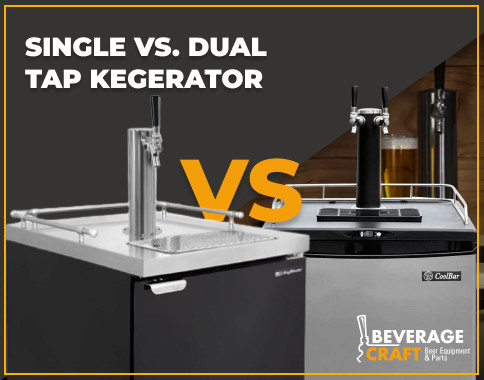Single Vs. Dual-Tap Kegerator
Posted by Ron on 10th Jul 2023
Both single and dual-tap kegerators offer a simple and convenient way to dispense draft beer in the comfort of your home. However, there are a few notable differences between the two, that may affect your choice.
Here in this Beverage Craft blog article, we talk about the pros and cons of single and dual tap kegerators, as well as sharing some tips on how to know which one is right for you.
What Is a Single-Tap Kegerator?
A single-tap kegerator is a draft beer dispensing device that allows you to pour and enjoy fresh, cold beer from a kegerator at home. As you may have probably guessed from the name, it contains one tap tower and allows you to pour only one style of beer at a time (unlike the dual keg kegerator).
Single-Tap Kegerator Pros
One of the main pros of 1 tap kegerators is the convenience it offers. Instead of having to buy individual bottles or cans of beer, you can have a keg stored in your kegerator, ensuring a constant supply of fresh beer.
Another big advantage is the superior taste and quality of draft beer. Unlike bottled beer, which can often lose carbonation or go stale, beer from a kegerator is typically perfectly carbonated and retains its best quality.
A single-tap kegerator is relatively easy to install and use. Most models come with a CO2 tank and regulator, allowing you to control the carbonation and pressure levels to match your taste preferences.
Single-Tap Kegerator Cons
One major downside of a single-tap kegerator is the lack of variety. With just one tap, you can only have a single style of beer available at a time. If you enjoy trying different styles or sharing drinks with guests who have varied preferences, a single-tap kegerator may be limiting.
A single-tap kegerator also requires regular maintenance and cleaning. This includes cleaning the lines and components, as well as replacing seals and washers periodically. Failure to maintain the kegerator can lead to beer quality issues and costly repairs.
What Is a Dual-Tap Kegerator?
A dual-faucet kegerator is a popular choice among both draft beer enthusiasts and homebrewers. Double tap kegerators allow you to have two separate kegs of beer on tap at the same time, providing greater variety. Here are the main pros and cons of 2 tap kegerators.
Dual-Tap Kegerator Pros
One of the biggest advantages of a dual-tap kegerator is the ability to serve two different types of beer simultaneously. This is ideal for those who enjoy multiple beer styles or like to entertain guests with different preferences. You can have a hoppy IPA on one tap and a smooth lager on the other, catering to everyone's taste.
With a dual-tap kegerator, there’s no need to constantly swap out kegs. You can keep your favorite beers on tap longer without the hassle of changing kegs frequently.
Finally, a dual-tap kegerator allows you to have both kegs in one unit. This not only saves space but also reduces the need for additional equipment and maintenance.
Dual-Tap Kegerator Cons
The biggest and most obvious downside of dual-tap kegerators is that they typically come at a higher price compared to single-tap models, which may deter some budget-conscious buyers. If you rely heavily on the refrigerator section of the kegerator for food or beverage storage, you may also find the limited space to be a drawback.
The availability of kegs may vary depending on your location. While most areas have local breweries or distributors who provide kegs, the variety and selection may not be as extensive as bottled or canned beer options.
Can You Convert a Single-Tap Kegerator to a Dual-Tap?
Can you convert a single-tap kegerator to a double-tap? Yes, you can. All you need is a double tap conversion kit ( best kegerator conversion kits), consist of an extra faucet, shank, beer line, gas line, fittings, and connectors, a bunch of household tools, and some basic DIY skills. Here's a quick guide on how to do the conversion.
- Disconnect and remove the existing tap
Remove the faucet, shank, and any associated connections (beer line and gas line). Make sure to turn off the CO2 and release any remaining pressure in the kegerator before proceeding. -
Drill a new hole (if applicable)
If your kegerator doesn't have an existing hole for the second tap, you'll need to drill one. Choose a suitable location that provides enough space between taps and ensures easy access for pouring and maintenance. - Install the second faucet and shank
Attach the new faucet and shank in the designated location, using the appropriate fittings and connectors. - Connect the beer and gas lines
Make sure to use hose clamps to secure the connections and prevent any potential leaks. - Reconnect the CO2 tank
Reattach the CO2 tank to the kegerator and turn on the gas supply. Check for any leaks by applying a soapy water solution to the connections.
Single-Tap vs. Dual-Tap Kegerators: Choosing the Right One for You
If you’re still not sure about the single-tap vs. double-tap question, consider these two additional factors:
- Costs (dual-tap commercial kegerators require higher initial costs while providing more variety)
- Maintenance and cleaning using a kegerator beer line cleaning kit (some people may find this process to be time-consuming or overwhelming)
Other than that, multiple tap kegerators are generally a more preferable option.
